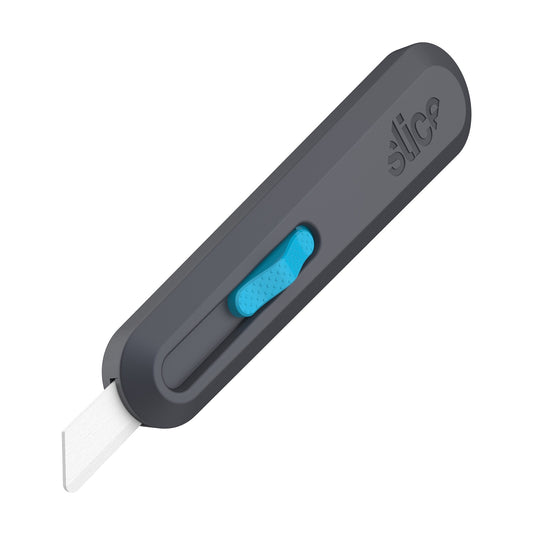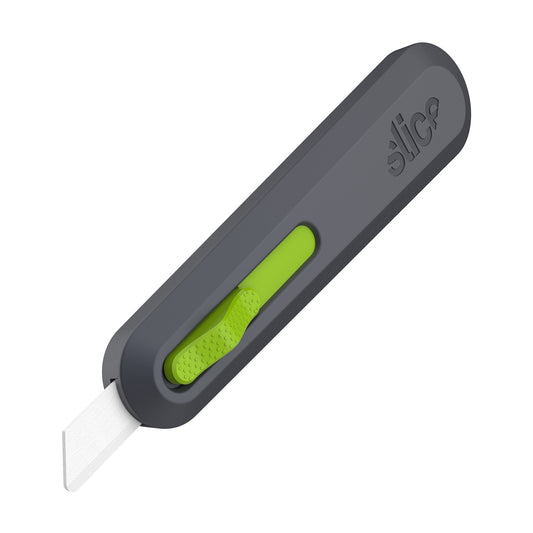SKU #10550
Cuttermesser
Das Slice 10550 Cuttermesser ist eines von drei Modellen mit jeweils unterschiedlichen Griffen. Dieses Modell bietet fünf Klingenpositionen, um die Klingentiefe je nach Aufgabe anpassen zu können. Dank eines innovativen Herstellungsprozesses werden bei Slice Keramikklingen produziert, die sicher für Ihre Finger sind. Wie unsere anderen Modelle verfügt auch das manuelle Sicherheits-Cuttermesser über einen robusten Griff aus glasfaserverstärktem Nylon und langlebige, austauschbare Klingen. Slice Keramikklingen sind funkenfrei, unmagnetisch und chemisch inert. Sie rosten nicht und sind hitzestabil bei Temperaturen bis zu 1600 °C.
- Griffmodell: 5 Klingenpositionen
- Robuster Griff aus glasfaserverstärktem Nylon
- Passende Klingen: 10526, 10528
- Sicherheitsklinge, die 11x länger scharf bleibt
- Minimiertes Verletzungsrisiko, geringere Kosten
- Funkenfreie, nicht leitende Klinge
- Beidhändig nutzbar
- Hat ein Loch für Ihr Schlüsselband, damit Sie das Werkzeug immer zur Hand haben
- Werkzeugloser Klingentausch
- Weniger Klingenwechsel = weniger Verletzungen
- Art.-Nr. 10550
Great for:
- Removing plastic packaging
- Opening cardboard boxes
- Opening packages coming through the garage
- Stripping cables
Produktdetails
Produktdetails
Cutting Depth:
Material: GFN, POM, Carbon Steel, zirconium oxide
Dimensions: L x W x H
Weight: 0.094 kg






Videos
-
Manual Utility Knife
-
Stripping Wire Insulation: Choose the Safest Tool
-
How to Cut Ceiling Tile: Safety First
-
Cutting Ram Board®
-
How to Cut Super Sacks® Easily and Safely
-
How to Cut Visqueen Reinforced Plastic
-
Blade Replacement for Slice Utility Knives
FAQ - Häufige Fragen
What Is a Utility Knife Used For?
This type of knife is used for a wide variety of tasks and materials, usually ones that require a sturdy, durable tool. Utility knife uses include scraping, piercing, or cutting, and materials include wire, carpeting, nylon straps, and metal sheets.
Is a Ceramic Utility Knife Safer?
A Slice utility knife is a safety tool because our proprietary grind creates a finger-friendly edge that effectively cuts most materials but resists cutting skin. And because advanced ceramics are much harder than steel, Slice blades last, on average, 11.2 times longer than steel blades.
What Kind of Utility Knife Blades Does Slice Offer?
To distinguish our different utility knife blade types, we look at how the blade is integrated with the handle. The Manual Utility Knife offers five fixed positions for blade, allowing the user to choose blade depth and keep the blade extended when it’s not in use. The Auto-Retractable Utility Knife has a slider button that must be engaged in order to extend the blade. This reduces injuries by ensuring that the blade is never left exposed when it’s not in use. Our Smart-Retracting Utility Knife has an added layer of safety. Its innovative technology senses when the blade loses contact with the cutting surface and automatically retracts the blade, even when the user is still holding the slider button.












